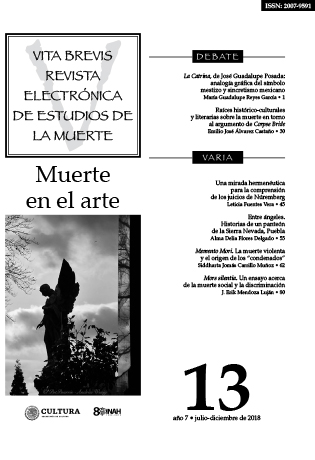Debate
Raíces histórico-culturales y literarias sobre la muerte en torno al argumento de Corpse Bride
Published 2018-12-31
Keywords
- Tim Burton,
- marriage after death,
- legends,
- Don Juanism,
- Espronced
How to Cite
Raíces histórico-culturales y literarias sobre la muerte en torno al argumento de Corpse Bride . (2018). Vita Brevis, 13, 30-44. https://revistas.inah.gob.mx/index.php/vitabrevis/article/view/15137
Abstract
The script of Tim Burton’s Corpse Bride is based on a Jewish legend featuring a marriage after death. On the one hand, different literary aspects concerning this legend and variants of its historical survival will be discussed. On the other hand, it will be shown how the script departs from the legend at a certain point and takes features from the literary subject of Don Juanism, since there is a special parallel with José de Espronceda’s El estudiante de Salamanca, which makes it possible to elude a tragic ending.
Downloads
Download data is not yet available.
References
- Huang, Hua-Lun, The Missing Girls and Women of China, Hong Kong, and Taiwan: A Sociological Study of Infanticide, Forced Prostitution, Political Imprisonment, “Ghost Brides”, Runaways and Thrownaways, 19002000, Jefferson, McFarland & Company, 2012.
- Ikels, Charlotte, “Parental Perspectives on the Significance of Marriage”, Journal of Marriage and Family, núm. 47 (2), 1985, pp. 253-264.
- Klier, John Doyle, y Shlomo Lambroza (eds.), Pogroms: Anti-Jewish Violence in Modern Russian History, Cambridge, Cambridge University Press, 2004.
- Martin, Diana, “Chinese Ghost Marriage”, en H. bAkeR y S. Feuchtwang (eds.), An Old State in New Settings: Studies in the Social Anthropology of China in Memory of Maurice Freedman, Oxford, JASO, 1991, pp. 25-43.
- Noyes, Deborah, Encyclopedia of the End, Nueva York, Houghton Mifflin Company, 2008.
- Page, Edwin, Gothic Fantasy: The Films of Tim Burton, Londres, Marion Boyars Publishers, 2007.
- Pfefferman, Naomi, “Tim Burton’s Corpse Bride has Jewish bones”, en The Jewish News of Northern California, 16 de septiembre de 2005, recuperado de: http://www.jweekly.com/2005/09/16/tim-burton-s-corpse-bride-has-jewish-bones/ consultada el 26 de enero de 2017.
- Perón Sobero, Macarena, “Tim Burton y el expresionismo alemán”, Creación y Producción en Diseño y Comunicación, núm. 35, 2010, p. 115-117.
- Poznar, Walter, “Orpheus Descending: Love in Vertigo”, Literature/Film Quarterly, núm. 17 (1), 1989, pp. 59-65.
- Salisbury, Mark (ed.), Burton on Burton, Londres, Faber, 2006.
- Schroeder, David, Hitchcock´'s Ear: Music and the Director´'s Art, Nueva York, Continuum, 2012.
- Schwartz, Howard, Reimagining the Bible: The Storytelling of the Rabbis, Oxford, Oxford University
- Press, 1998.
- Schwartz, Howard (ed.), Lilith’s Cave: Jewish Tales of the Supernatural, Oxford, Oxford University Press, 1988.
- Schwartze, Lucas J., “Grave Vows: A Cross-Cultural Examination of the Varying forms of a Ghost Marriage among Five Societies”, Nebraska Anthropologist, núm. 60, 2010, pp. 82-95.
- Topley, Marjorie, Cantonese Society in Hong Kong and Singapore: Gender, Religion, Medicine and Money, Hong Kong, Hong Kong University Press, 2011.
- Tseng, Wen-Shing, y Jing Hsu, Culture and Family: Problems and Therapy, Nueva York, Haworth Press, 1991.
- Verdaguer, Jacinto, La Atlántida (trad. de Melchor de Palau), Barcelona, Estampa de Fidel Giró, 1886.
- Williams, Victoria, Celebrating Life Customs around the World: From Baby Showers to Funerals, vol. 1. Santa Bárbara, Abc-Clío, 2017.
- Yao, Ping, “Until Death Do Us Unite: Afterlife Marriages in Tang China, 618-906”, Journal of Family History, núm. 27 (3), 2002, pp. 207-226.

